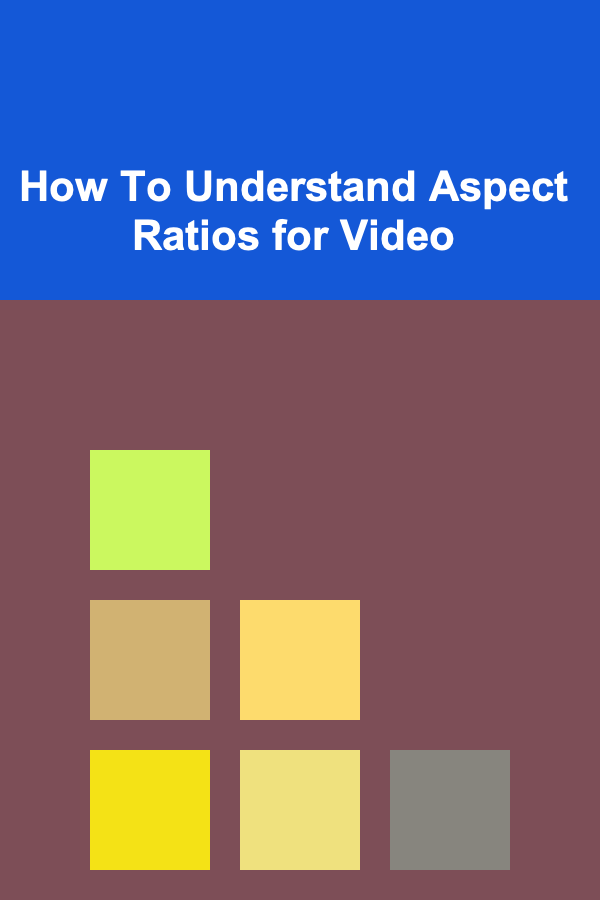
How To Understand Aspect Ratios for Video
ebook include PDF & Audio bundle (Micro Guide)
$12.99$9.99
Limited Time Offer! Order within the next:

Aspect ratios are fundamental when it comes to video production and viewing experiences. Understanding them is essential for anyone working with video content, from filmmakers and videographers to marketers and social media managers. But what exactly is an aspect ratio, and why does it matter? In this article, we'll dive into the concept of aspect ratios, how they work, and why they are crucial for video creation and distribution.
What is an Aspect Ratio?
The aspect ratio refers to the proportional relationship between a video's width and its height. It's typically expressed as two numbers separated by a colon, such as 16:9 or 4:3. The first number represents the width, while the second represents the height. So, a video with an aspect ratio of 16:9 is 16 units wide for every 9 units of height.
In a broader context, aspect ratios can apply to any visual medium, including film, photography, and digital screens. However, for video, it primarily affects how the image is displayed on a screen, influencing how people perceive content.
Common Aspect Ratios
Aspect ratios vary greatly depending on the medium, platform, and purpose of the video. Below are the most common aspect ratios used in video production.
1. 16:9 (Widescreen)
16:9 is the most widely used aspect ratio, particularly for modern televisions, computer monitors, and online platforms like YouTube, Vimeo, and Netflix. It's also the standard for HD (1080p) and 4K video resolution. The 16:9 aspect ratio is considered ideal for high-definition content, as it balances widescreen and vertical space effectively, providing an immersive viewing experience.
Why Use 16:9?
- Widescreen compatibility: Ideal for cinematic and television-style content.
- HD and 4K standards: Most high-definition content is filmed or broadcasted in this aspect ratio.
- Versatility: Works well across a wide range of devices, from smartphones to large screens.
2. 4:3 (Standard Definition)
4:3 was once the standard aspect ratio for televisions and computer monitors. It's now mostly used for legacy content, such as old television broadcasts and video archives. While 16:9 has replaced 4:3 as the dominant aspect ratio in modern viewing, 4:3 is still relevant in certain niche applications, such as retro-style video games and certain vintage aesthetics.
Why Use 4:3?
- Classic look: Offers a nostalgic, old-school aesthetic that's sometimes desired in artistic productions.
- Professional use: Some legacy systems or specialized equipment may still use the 4:3 aspect ratio.
3. 21:9 (Cinemascope or Ultra-Wide)
21:9 is a much wider aspect ratio that is often used in cinema, particularly for epic films that require a wide field of view. It's commonly referred to as "CinemaScope" or "ultra-wide," as it provides a more cinematic and immersive experience compared to the standard 16:9 aspect ratio. This aspect ratio is increasingly popular in high-end home theaters and is used in some modern video games to enhance the feeling of being immersed in a virtual world.
Why Use 21:9?
- Cinematic feel: Ideal for wide shots and large-scale cinematography.
- Immersion: Provides an enveloping experience, making viewers feel like they are a part of the action.
- Enhanced visual storytelling: Allows for more complex compositions and grander visual narratives.
4. 1:1 (Square)
The 1:1 aspect ratio is gaining popularity on social media platforms like Instagram, particularly for posts and stories. With a square format, the visual elements are evenly balanced, making it ideal for mobile devices, where users typically engage with content that fits perfectly within a smartphone screen.
Why Use 1:1?
- Social media optimization: Perfect for Instagram and other platforms that favor square images or videos.
- Simplicity: The symmetrical aspect ratio is easy to compose and aesthetically pleasing.
- Mobile-friendly: Optimized for viewing on mobile devices, where square videos are more engaging.
5. 9:16 (Vertical)
9:16 is a vertical aspect ratio that is predominantly used for mobile video content, especially on platforms like TikTok, Snapchat, and Instagram Stories. It's the inverse of the 16:9 ratio, designed specifically for smartphones held in portrait orientation. This aspect ratio has become crucial for creating content that resonates with a mobile-first audience.
Why Use 9:16?
- Mobile-first design: Perfect for social media apps that prioritize vertical videos.
- Better user experience: Provides a more natural viewing experience when holding a smartphone in portrait mode.
- Maximizes screen space: Utilizes the full screen area of a smartphone.
Why Aspect Ratios Matter
Understanding aspect ratios is vital for several reasons, as they directly affect the aesthetic quality of a video, its compatibility with platforms, and how effectively it conveys a message to viewers.
1. Compatibility with Devices and Platforms
Different devices and platforms have distinct requirements for aspect ratios. For example, if you're uploading a video to YouTube, the platform will automatically adjust the video to fit the 16:9 aspect ratio, which is optimal for widescreen viewing. If your video doesn't match this aspect ratio, you could end up with black bars on the sides (letterboxing or pillarboxing), which can make the video less visually appealing.
For social media platforms like Instagram or TikTok, each has its own preferred aspect ratio for videos. If you create content in an incorrect aspect ratio, it might not display as intended, affecting its engagement and viewership.
2. Aesthetic Appeal
The aspect ratio also plays a role in the artistic and aesthetic appeal of the video. Certain aspect ratios lend themselves to specific visual styles. For example, the 21:9 ratio is often used in film to create sweeping landscapes and epic, wide-angle shots. On the other hand, the 1:1 square ratio emphasizes symmetry and balance, making it ideal for clean, minimalistic designs.
By choosing the right aspect ratio for your project, you can help convey the intended mood, focus the viewer's attention, and enhance the overall experience. The aspect ratio you choose can guide the composition of each shot, how much of the scene is visible, and how the story is told visually.
3. Resolution and Quality
The resolution of a video is closely tied to its aspect ratio. In particular, video formats like 1080p and 4K are often tied to the 16:9 aspect ratio. If you change the aspect ratio, the video's resolution might need to be adjusted as well to avoid pixelation or a loss of quality.
For example, while a 16:9 video in 4K resolution looks sharp on a widescreen TV, a 21:9 video in the same resolution will appear much wider and may require higher processing power to maintain quality.
How to Choose the Right Aspect Ratio for Your Video
Choosing the right aspect ratio for your video depends on several factors:
1. Platform and Device Considerations
As we've discussed, different platforms favor different aspect ratios. Here's a quick guide for common platforms:
- YouTube: 16:9 is the standard for YouTube videos.
- Instagram Feed: Square (1:1) or portrait (4:5) for the best engagement.
- Instagram Stories and Snapchat: Vertical videos (9:16).
- TikTok: Vertical (9:16) is the preferred aspect ratio.
- Twitter: 16:9 works well, but you can also use square (1:1).
- Facebook: 16:9 or square (1:1) works for both video posts and ads.
2. Content Type
The content itself can also influence your decision. If you're producing cinematic content, you might opt for a 21:9 aspect ratio to enhance the grandeur of the shots. For mobile-focused or social media content, a vertical 9:16 ratio might be your best bet.
3. Storytelling Needs
Think about how you want to frame your subject matter. A wider aspect ratio, like 16:9 or 21:9, works well for scenes with large landscapes or group shots. In contrast, a square or vertical format might be better for close-ups or portraits.
Conclusion
Aspect ratios are more than just technical specifications---they directly impact the way we experience and perceive video content. By understanding the significance of aspect ratios, you can create videos that are not only technically sound but also visually engaging. Whether you are creating content for traditional media, digital platforms, or social media, the aspect ratio you choose can make a world of difference in how your video is received and appreciated by your audience.
In the world of video production, knowing how to work with aspect ratios is an essential skill that can help you maximize your video's impact, ensure compatibility with various devices and platforms, and convey your artistic vision with precision. So, next time you sit down to create a video, consider your aspect ratio carefully---it's an essential tool in telling your story the way you want it to be told.

How to Build a Seasonal Garden Maintenance Checklist
Read More
How to Create a Checklist for Engaging Followers with Polls, Quizzes, and Surveys
Read More
Monetizing Deep Learning: Building a Profitable Portfolio
Read More
How to Speak with Passion and Conviction
Read More
How To Create a Positive Money Mindset for FIRE
Read MoreMood Tracking for Gamers: 10 Strategies to Improve Wellbeing
Read MoreOther Products

How to Build a Seasonal Garden Maintenance Checklist
Read More
How to Create a Checklist for Engaging Followers with Polls, Quizzes, and Surveys
Read More
Monetizing Deep Learning: Building a Profitable Portfolio
Read More
How to Speak with Passion and Conviction
Read More